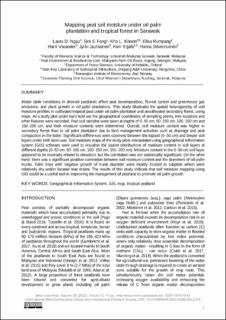| dc.contributor.author | Ngau, Laura D. | |
| dc.contributor.author | Fong, Sim S. | |
| dc.contributor.author | Khoon, Kho L. | |
| dc.contributor.author | Rumpang, Elisa | |
| dc.contributor.author | Vasander, Harri | |
| dc.contributor.author | Jauhiainen, Jyrki | |
| dc.contributor.author | Yrjälä, Kim | |
| dc.contributor.author | Silvennoinen, Hanna Marika | |
| dc.date.accessioned | 2022-12-27T14:02:35Z | |
| dc.date.available | 2022-12-27T14:02:35Z | |
| dc.date.created | 2022-09-23T13:10:43Z | |
| dc.date.issued | 2022 | |
| dc.identifier.citation | Mires and Peat. 2022, 28 1-17. | en_US |
| dc.identifier.issn | 1819-754X | |
| dc.identifier.uri | https://hdl.handle.net/11250/3039572 | |
| dc.description.abstract | Water table conditions in drained peatlands affect peat decomposition, fluvial carbon and greenhouse gas emissions, and plant growth in oil palm plantations. This study illustrates the spatial heterogeneity of soil moisture profiles in cultivated tropical peat under oil palm plantation and uncultivated secondary forest, using maps. At a study plot under each land use the geographical coordinates of sampling points, tree locations and other features were recorded. Peat soil samples were taken at depths of 0–50 cm, 50–100 cm, 100–150 cm and 150–200 cm, and their moisture contents were determined. Overall, soil moisture content was higher in secondary forest than in oil palm plantation due to land management activities such as drainage and peat compaction in the latter. Significant differences were observed between the topsoil (0–50 cm) and deeper soil layers under both land uses. Soil moisture maps of the study plots interpolated using geographical information system (GIS) software were used to visualise the spatial distributions of moisture content in soil layers at different depths (0–50 cm, 50–100 cm, 100–150 cm, 150–200 cm). Moisture content in the 0–50 cm soil layer appeared to be inversely related to elevation, but the correlation was not statistically significant. On the other hand, there was a significant positive correlation between soil moisture content and the diameters of oil palm trunks. Palm trees with negative growth of trunk diameter were mostly located in subplots which were relatively dry and/or located near drains. The results of this study indicate that soil moisture mapping using GIS could be a useful tool in improving the management of peatland to promote oil palm growth. | en_US |
| dc.language.iso | eng | en_US |
| dc.rights | Navngivelse 4.0 Internasjonal | * |
| dc.rights.uri | http://creativecommons.org/licenses/by/4.0/deed.no | * |
| dc.title | Mapping peat soil moisture under oil palm plantation and tropical forest in Sarawak | en_US |
| dc.title.alternative | Mapping peat soil moisture under oil palm plantation and tropical forest in Sarawak | en_US |
| dc.type | Peer reviewed | en_US |
| dc.type | Journal article | en_US |
| dc.description.version | publishedVersion | en_US |
| dc.rights.holder | © 2022 The Authors | en_US |
| dc.source.pagenumber | 1-17 | en_US |
| dc.source.volume | 28 | en_US |
| dc.source.journal | Mires and Peat | en_US |
| dc.identifier.doi | 10.19189/MaP.2022.OMB.StA.2370 | |
| dc.identifier.cristin | 2054825 | |
| dc.source.articlenumber | 13 | en_US |
| cristin.ispublished | true | |
| cristin.fulltext | original | |
| cristin.qualitycode | 1 | |

